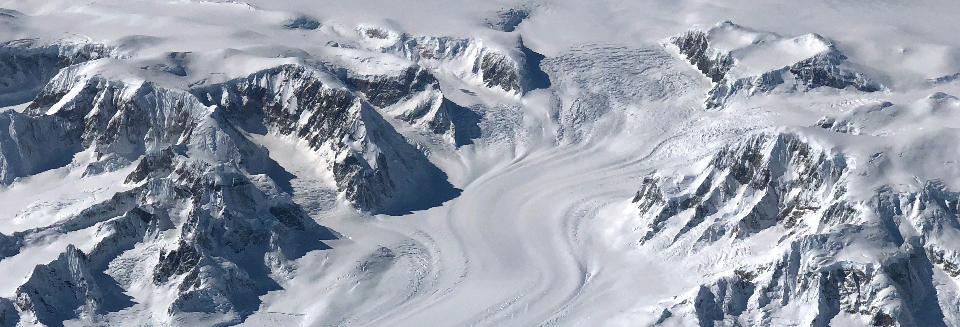

Photo from climate.gov
My research focuses on periods during the last glaciation when atmospheric CO2 concentrations changed abruptly. To do this, I measure ancient atmosphere that's frozen as tiny bubbles in West Antarctic Ice Sheet (WAIS) Divide ice core. I am investigating these abrupt changes in extreme detail - up to decadal timescales - in order to understand how in Earth's carbon cycle has rapidly changed in the past.
PI: Dr. Christo Buizert, Oregon State University
Wendt, K. A., Nehrbass-Ahles, C., Niezgoda, K., Noone, D., Kalk, M., Menviel, L., Gottschalk, J., Rae, J., Schmitt, J., Fischer, H., Stocker, T., Muglia, J., Ferreira, D., Brook, E., and Buizert, C. (In Press). Abrupt Southern Ocean CO2 Ventilation during Heinrich Stadials. Proceedings of the National Academy of Sciences.
Wendt, K. A., Bennett, H. I., Carter, A. J., and Marks-Peterson, J. C. (2022) Our frozen past: Ice core insights into Earth's climate history, PAGES Magazine, Link.
Photo by Robbie Shone
Devils Hole cave is located in the Amargosa Desert of southwest Nevada. The walls of the cave are coated with a thick calcite crusts that have precipitated subaqueously for nearly 1 million years. Our project builds upon previous paleoclimate studies in Devils Hole in order to reconstruct nearly 700,000 years of climate history in this region. This timeframe will allow us to examine the last eight glacial-interglacial cycles recorded in this unique terrestrial archive. In addition, we are studying how the water-table has fluctuated over these glacial-interglacial cycles. Doing so will allow us to better understand past wet periods that once prevailed in thisarid region.
PI: Dr. Christoph Spötl, University of Innsbruck
Wendt, K.A., Carolin, S., Steidle, S. D., Dublyansky, Y., Moseley, G.E., Cheng. H., Edwards, R.L., Spötl, C. (in prep) Great Basin climate over the last 740,000 years: the revised Devils Hole record.
Jackson, T. R., Steidle, S. D., Wendt, K. A., Dublyansky, Y., Edwards, R. L., and Spötl, C. (2023) A 350,000-year history of groundwater recharge in the southern Great Basin, USA., Nature Communications in Earth and Environment. Link
Li, X., Wendt, K. A., Dublyansky, Y., Moseley, G. E., Spötl, C., and Edwards, R. L. (2021) Novel method for determining 234U-238U ages from Devils Hole 2 cave calcite, Geochronology Link
Wendt, K.A., Pythoud, M., Dublyansky, Y., Moseley, G.E., Edwards, R.L., Spötl, C. (2020) Paleohydrology of southwest Nevada based on groundwater 234U/238U over the last 450ka. GSA Bulletin, 132 (3-4) 793–802 Link
Wendt, K.A., Dublyansky, Y., Moseley, G.E., Cheng. H., Edwards, R.L., Spötl, C. (2018) Moisture availability in the SW United States over the last three glacial-interglacial cycles. Science Advances, 4 (10) eaau1375 Link
Moseley, G.E., Edwards, R.L., Wendt, K.A., Cheng, H., Dublyansky, Y., Lu, Y., Boch, R., Spötl, C. (2016): Reconciliation of the Devils Hole climate record with orbital forcing. Science 351, 165-168 Link
Beneath the parched deserts of NE Brazil is a vast network of caves. Within these caves are stalagmites and stalactites that grew during past wet periods. For my MSc project, I studied a series of these anomalous wet periods that occurred during the last glaciation. To do so, I used high precision uranium-series dating and stable isotope analysis on multiple stalagmites collected from NE Brazilian caves.
PI: Dr. R. L. Edwards, University of Minnesota
Wendt, K.A., Häuselmann, A.D., Fleitmann, D., Berry, A.E., Wang, X., Auler, A.S., Cheng, H., Edwards, R. L. (2019) Three-Phased Heinrich Stadial 4 recorded in NE Brazil Stalagmites. Earth and Planetary Science Letters, 510, 94-102 Link
© Copyright Kathleen Wendt
Make a free website with Yola